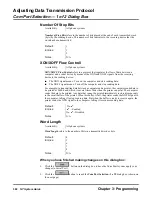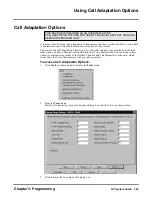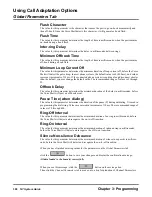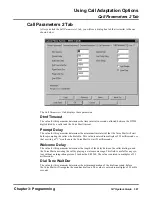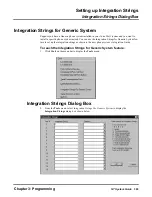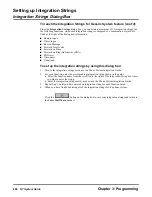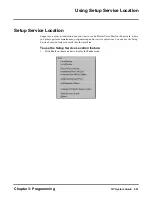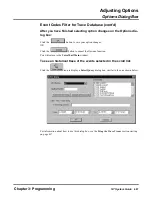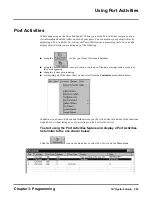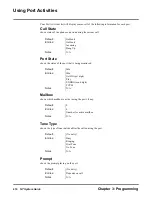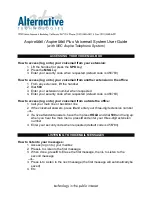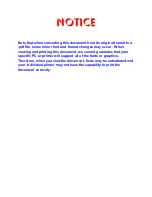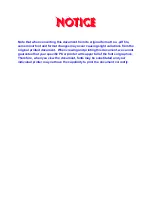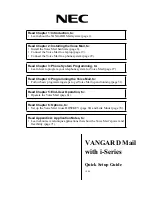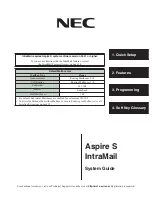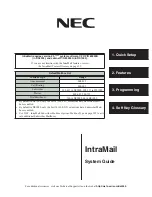
Using Call Adaptation Options
Call Parameters 1 Tab
396
NT System Guide
Chapter 3: Programming
OnHook Duration
The value for this parameter determines the minimum duration in milliseconds of onhook time,
before the Voice Mail will recognize the onhook condition. You can change this value, if your
phone system requires a Voice Mail port to be onhook for a specified duration. This value is entered
in multiples of 55 milliseconds, so that a setting of “1” would cause the Voice Mail to wait 55 mil-
liseconds before recognizing the onhook condition. The recommended range of values is 1
–
73
.
UseSoundAsDialTone
The value for this parameter determines how the Voice Mail will identify dial tone. On most phone
systems, the default is 2. A setting of “2” causes the Voice Mail to use the tone table to detect dial
tone. But if the Voice Mail cannot detect the phone system’s dial tone, change this value to a “1.” A
setting of “1” lets the Voice Mail treat any sound as dial tone.
Note:
If you change this value to “1”, you must next change the Dial Tone String on the Call Parameters
2 tab to “S” (for sound). Then in all Voice Mail programming options where a “W” was pro-
grammed, change every “W” to an “S” systemwide.
UTransferDelay
The value for this parameter determines the minimum duration in milliseconds that the Voice Mail
will wait for an unscreened transfer (UTRF) before going onhook. If the Voice Mail is programmed
for unscreened transfers and the phone system requires a brief pause before going onhook to com-
plete this transfer, then you can raise this value to equal the time needed. In some phone systems,
this delay is required so that the proper integration will be sent when the call returns to the Voice
Mail. The recommended range of values is 1 through 73, where 1 = 55 ms.
ConversationLength
The value for this parameter determines the maximum amount of time in seconds, allowed for the
Voice Mail to record a conversation.
LampRefreshInterval
The value for this parameter determines the interval between one message waiting lamp update and
the next update. In most phone systems, this value defaults to 900. The recommended range of
value is 0 through 72. A “0” setting will disable lamp updates.
InRings
The values for this parameter determine the minimum number of complete ring cycles, before the
Voice Mail will answer an incoming call on any port from 1 up to the maximum number of Voice
Mail ports in your Voice Mail system. Incoming rings are the rings that present an incoming call to
the Voice Mail. Incoming calls include the calls made by internal callers to check on their new mes-
sages as well as external calls into the Voice Mail.
If you have finished making any changes on the Call Parameters 1
tab:
Click the
button to save your changes and display the confirmation message:
All data loaded to the board(s) successfully. When you see this message, click the
button on the message box.
Then click the Call Parameters 2 tab to move on to an explanation about other Call Parameters.
Summary of Contents for NVM-NT
Page 28: ...Table of Contents Chapter 5 Maintenance xxvi NT System Guide ...
Page 130: ...Installing SMDI 102 NT System Guide Chapter 3 Programming ...
Page 146: ...Customizing Caller I D Tables General Tab 118 NT System Guide Chapter 3 Programming ...
Page 156: ...Customizing Callout Options Optional Tab 128 NT System Guide Chapter 3 Programming ...
Page 182: ...Customizing Distribution Lists General Tab 154 NT System Guide Chapter 3 Programming ...
Page 338: ...Customizing Port Options General Tab 310 NT System Guide Chapter 3 Programming ...
Page 358: ...Customizing System Options Timers Tab 330 NT System Guide Chapter 3 Programming ...
Page 362: ...Customizing System Options Timers Tab 334 NT System Guide Chapter 3 Programming ...
Page 367: ...Customizing Tenant Options General Tab Chapter 3 Programming NT System Guide 339 ...
Page 396: ...Viewing and Printing Reports System Options Report 368 NT System Guide Chapter 3 Programming ...
Page 400: ...Performing a Local Backup Backup Dialog Box 372 NT System Guide Chapter 3 Programming ...
Page 440: ...Using Port Activities 412 NT System Guide Chapter 3 Programming ...
Page 454: ...Using Message Status Message Status Dialog Box 426 NT System Guide Chapter 3 Programming ...

